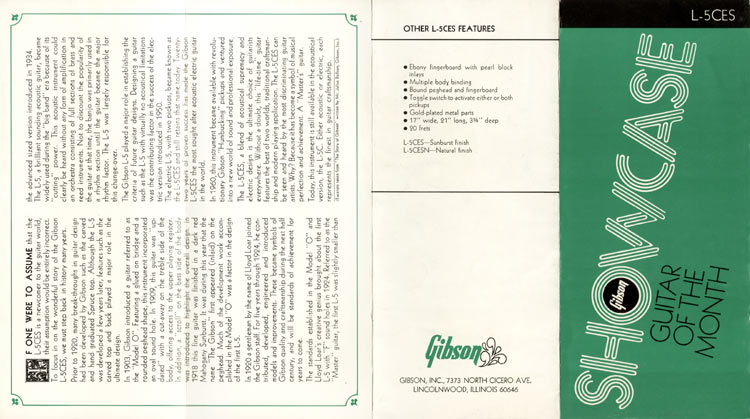
The Gibson L-5CES guitar of the month showcase leaflet from 1972 was a four-sided fold up document on a single sheet of paper. One side (here) shows the guitar with labelled features, whilst this side contained both front and rear cover, and a portion of text detailing the history of the instrument.

IF ONE WERE TO ASSUME that the L-5CES is a newcomer to the guitar world their assumption would be entirely incorrect. To focus in on the wonderful story of the Gibson L-5CES we must step back in history many years. Prior to 1920, many break-throughs in guitar design had been developed by Gibson such as the carved and hand graduated Spruce top. Although the L-5 was developed a few years later features such as the carved top and back played a major role in the ultimate design.
In 1903, Gibson introduced a guitar referred to as the "Model O". Featuring a glued on bridge and a rounded peghead shape this instrument incorporated an oval sound hole. In 1909 this guitar was "updated" with a cut-away on the treble side of the body, offering access to the upper playing register. In addition, a "scroll" on the bass side of the body was introduced to highlight the overall design. In 1918 this fine guitar was finished in a dark red Mahogany Sunburst. It was during this year that the name "The Gibson" first appeared (inlaid) on the peghead. Much of the development work accomplished in the Model "0" was a factor in the design of the first L-5.
In 1920 a gentleman by the name of Lloyd Loar joined the Gibson staff. For five years through 1924 he contributed, developed, engineered and introduced models and improvements. These became symbols of Gibson quality and craftsmanship during the next half century, and will be standards of achievement for years to come.
The standards established in the Model "0" and Lloyd Loar's creative genius brought about the first L-5 with "F" sound holes in 1924. Referred to as the "Master" guitar, the first L-5 was slightly smaller than the advanced sized version introduced in 1934. The L-5, a brilliant sounding acoustic guitar, became widely used during the "big band" era because of its "cutting" power. This acoustic instrument could clearly be heard without any form of amplification in an orchestra consisting of full sections of brass and reed instruments. Not to discount the popularity of the guitar at that time, the banjo was primarily used in a rhythm section until the guitar became the major rhythm factor. The L-5 was largely responsible for this change-over.
The Gibson L-5 played a major role in establishing the criteria of future guitar designs. Designing a guitar such as the L-5 with virtually no acoustical limitations was the contributing factor in the success of the electric version introduced in 1950. The electric L-5, with two pickups, became known as the L-5CES and still retains that name today. Twenty two years of proven success has made the Gibson L-5CES the most sought after acoustic electric guitar in the world.
In I960, this instrument became available with revolutionary Gibson "Humbucking" pickups and ventured into a new world of sound and professional exposure. The L-5CES, a blend of acoustical supremacy and electric design is the ultimate choice of guitarists everywhere. Without a doubt, this "life-time" guitar features the best of two worlds, traditional craftsmanship and modern playing application. The L-5CES can be seen and heard by the most discriminating guitar artists. Why? Because it has become a symbol of musical perfection and achievement. A "Master's" guitar. Today, this instrument is still available in the acoustical version, the L-5C. Either acoustic or electric, each represents the finest in guitar craftsmanship.
(Excerpts taken from "The Story of Gibson" written by Mr. Julius Bellson, Gibson, Inc.)
$12495
$9495
$9995
$495